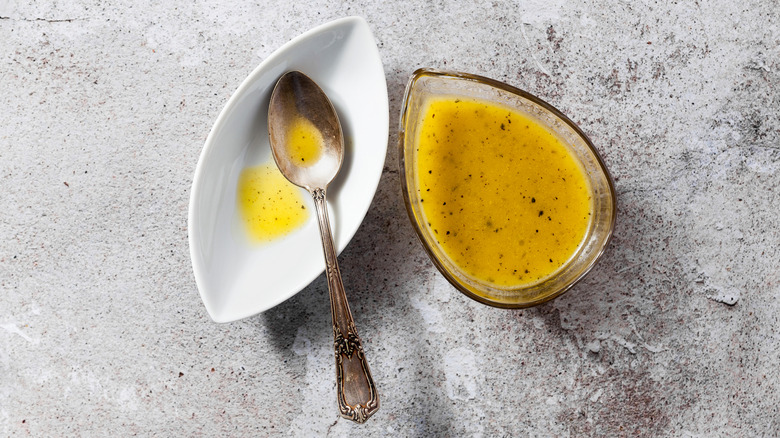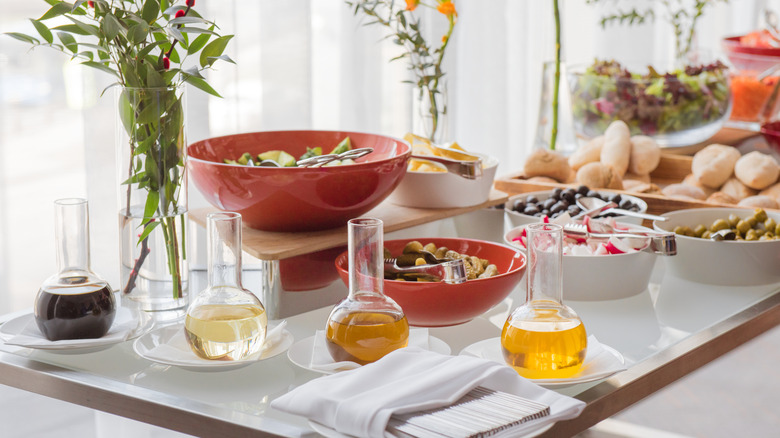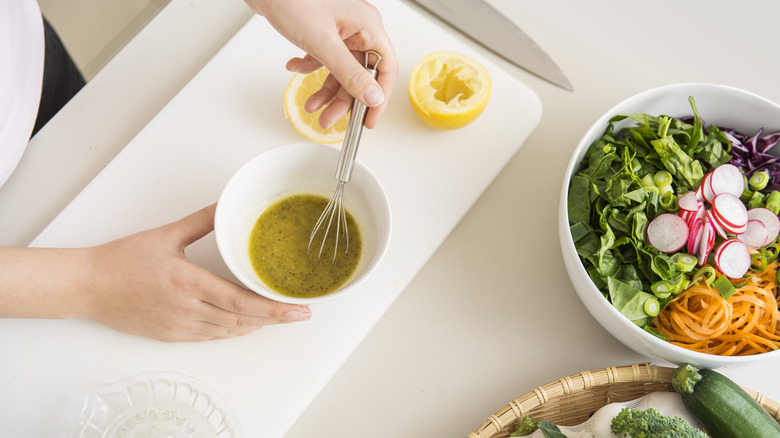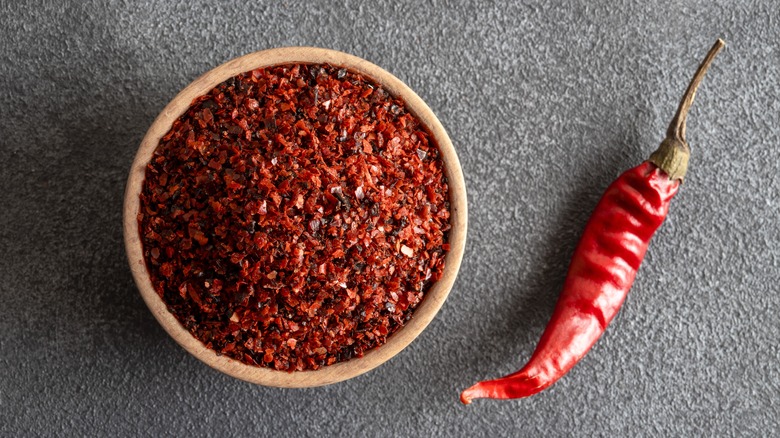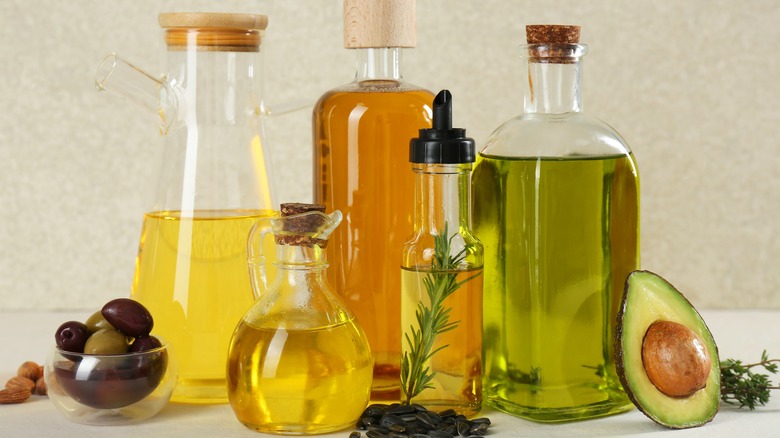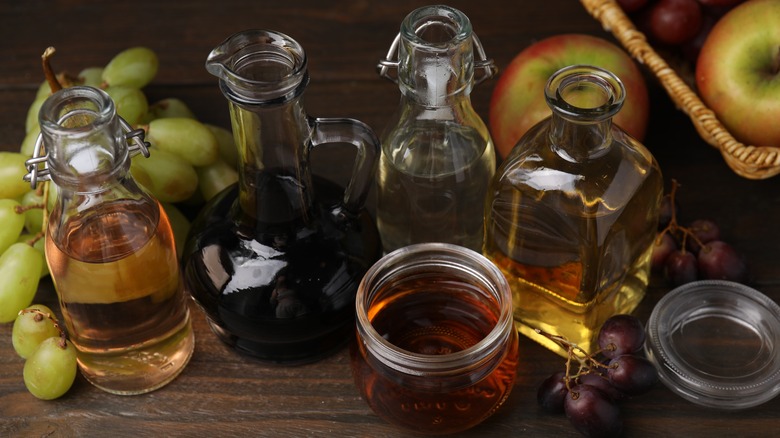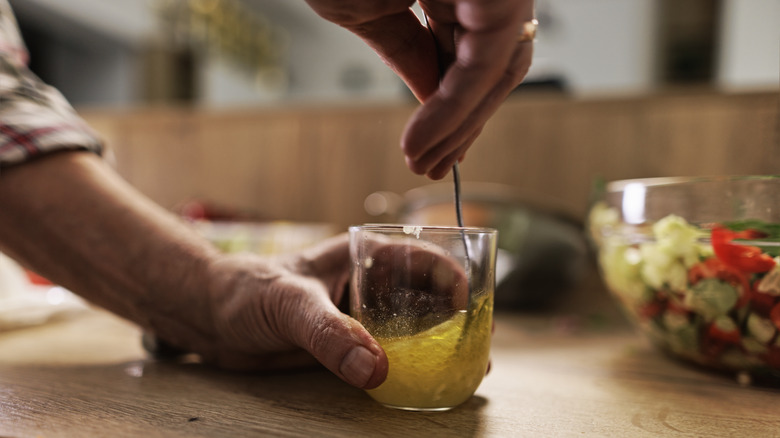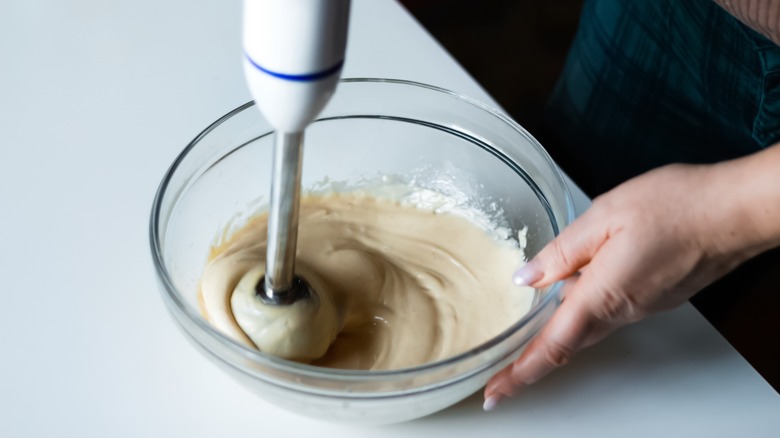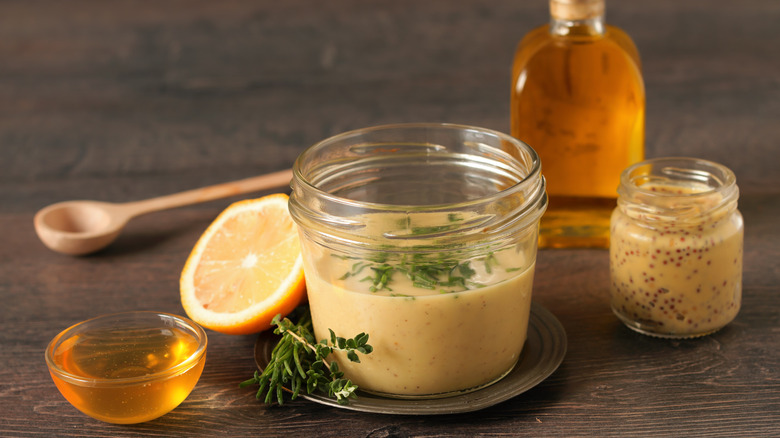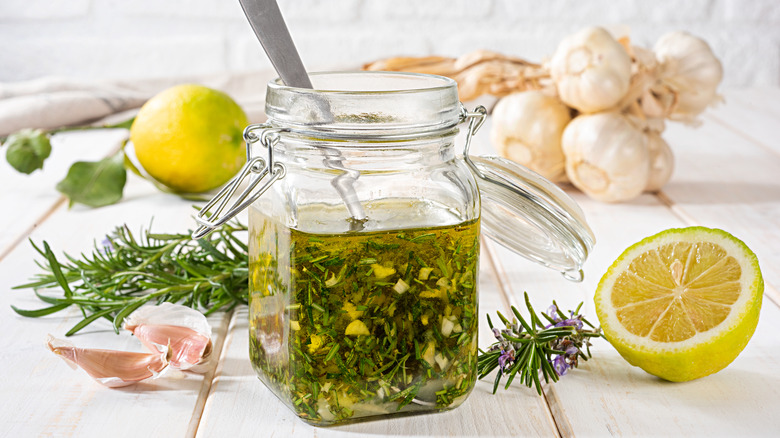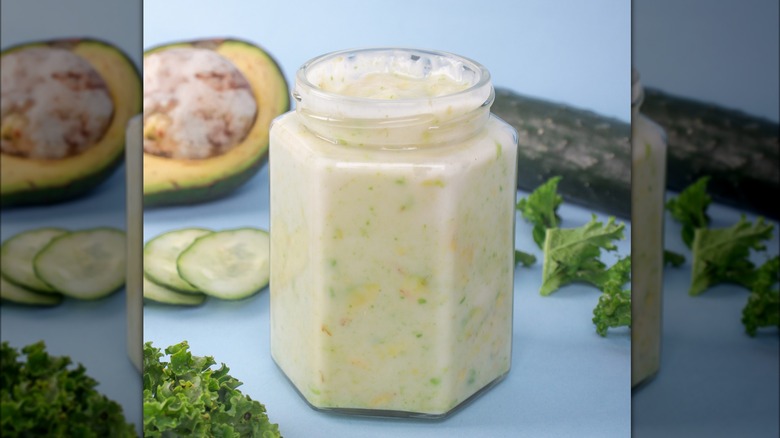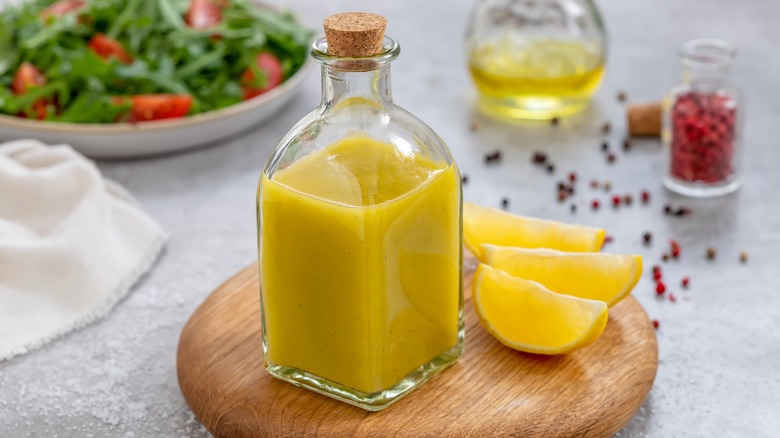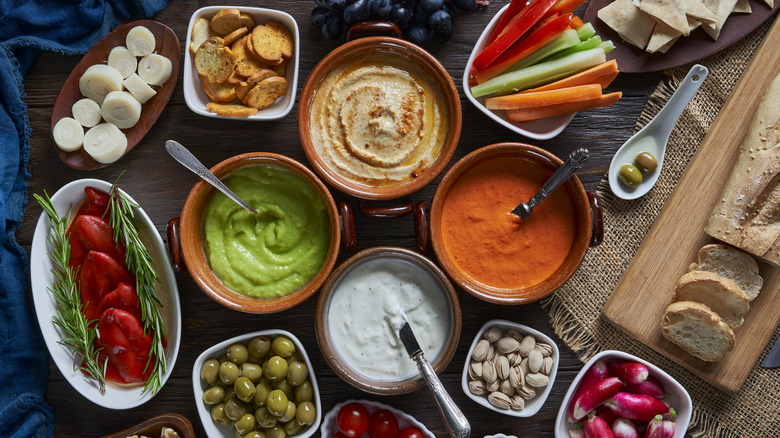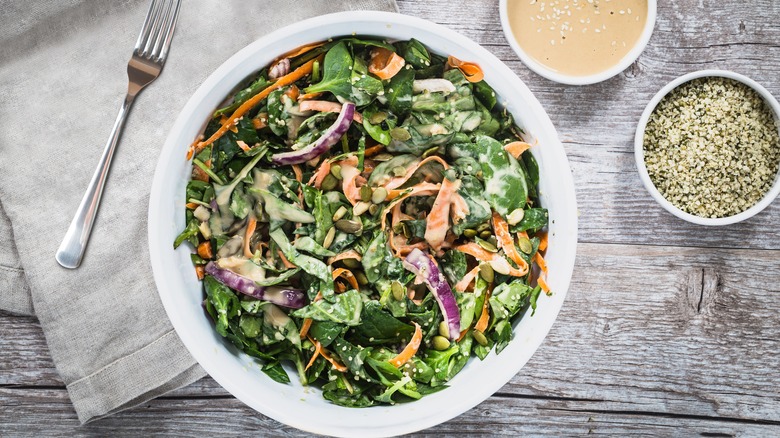Mistakes Everyone Makes With Salad Dressings
A good dressing can make or break a salad. If you view salads as tasteless or boring, it might be because you dress them with subpar ingredients or basic bottled dressing. Making your own from scratch is a better option, but there's still a lot that can go wrong. There are some mistakes everyone makes with salad dressings that leaves them lackluster and disappointing.
If you want to learn how to make the perfect adornment for your plate of veggies, it's important to understand these common errors and how best to avoid them. Whether you're sticking to the same old dressings and ingredients and missing out on other options, or you're existing dressings are either bland or overwhelming, we've got the solutions you need.
Never again will you have to force your way through a bad salad once you've learned about these typical dressing missteps. Once you know how to fix them or avoid them, your salad dressing game is going to be next-level.
Not enjoying all the varied types of salad dressing
One common mistake people make is assuming that salad dressing begins and ends with vinaigrette. There are actually many types of salad dressings — as well as sauces and dips that aren't usually used for salads but taste great on them. When you only ever use one type of dressing on salad, it's like only ever having marinara sauce on pasta. It's perfectly good, but what about pesto, Alfredo, or cacio e pepe?
Italian dressing is a twist on a classic vinaigrette, with the addition of extra herbs and spices. But you also have tangy, slightly spicy French dressing that contains ketchup and chili powder, among other ingredients. And, on the creamier end of the spectrum, Caesar and ranch dressings are both excellent options. There are lesser-known dressings, too, such as sesame-soy dressing or tahini sauce.
You can also use other dips and sauces as salad dressings, such as pesto, sweet chili sauce, or even hummus. So, there's no shortage of ways to dress a salad and sometimes you need to get out of your rut. There's absolutely a place for the classics, but using exactly the same dressing every time is a surefire way to get bored.
Making salad dressing too acidic
Most salad dressings have some kind of acidic component, from the vinegar in Italian dressing to the lemon juice and ketchup in Russian dressing. This gives depth and brightness in the right proportions. However, it's easy to overdo it and make your dressing too acidic.
You can usually avoid making dressing too acidic by following a recipe carefully but sometimes things go wrong. Perhaps you decided to branch out on your own and make up a dressing or maybe you used a different acidic ingredient from the one called for and it ended up more tart than you expected. Or it could just be that your measuring was off. Whatever the cause, you can learn how to fix a salad dressing that's overly acidic.
When you have too much of an acidic ingredient, this can be balanced out by rich, fatty elements. So, if you're making a vinaigrette or Italian dressing, you might just add more of whatever oil you're using in it. Alternative rich ingredients to add if you don't fancy more oil include tahini, mashed avocado, or nut butters. You can also try adding a bit more of every other ingredient in the recipe, bar the acidic ones. So, in a ranch dressing, you might add more mayonnaise and herbs, but leave out the extra sour cream, buttermilk, and lemon juice.
Making salad dressing too spicy
Some salad dressings contain spicy ingredients, such as the red pepper flakes in some Italian dressings and the chili powder in French dressing. However, it's easy to overdo it and make your dressing too fiery. Rather than adding a bit of heat and pep, it might leave you with tears streaming down your face, which is not what most people want from dinner.
Luckily, if you add too much heat to your dressing, there are ways to make it less spicy. If you have more of all the other ingredients, mix them in. If you use the same proportions as called for in the recipe, you'll get the same dressing, just less spicy. You can also fan the flames with nut butters or tahini paste, which can be tasty additions to some recipes.
Adding some mayonnaise is another option when you're making a creamy dressing or you don't mind transforming it into a creamy one. Sour cream, crème fraîche, and yogurt can have a similar effect. Sweet ingredients can also help to balance out spicy ones, so stirring in some sugar or honey might help. Although, if you've made your dressing very hot, sweetness alone is unlikely to fix it, so you might want to combine this option with another one. Between all these choices, you're bound to find one — or a combination of several — that will work for your dressing.
Using the wrong oil for the dressing
When making salad dressing, you might assume that any oil will do the trick but this isn't necessarily the case. While you're unlikely to make your dressing completely inedible by using the wrong oil, you might mess up the flavor profile. Either, you can end up with the oil overwhelming the dressing so you don't taste anything else, or you'll be left with lackluster results because the oil was supposed to do most of the heavy lifting, flavor-wise.
But, what do we mean by the wrong oil? There isn't a correct type to use that will work for every dressing — you need to look at the recipe or what's generally called for in a particular style of dressing. For instance, our five-ingredient French dressing recipe calls for a neutral oil, such as canola, vegetable, or a light refined olive oil. This lets the ketchup, vinegar, and flavors from other ingredients come through. The oil is more for texture than flavor. But, conversely, Greek dressing calls for quality extra-virgin olive oil — and plenty of it. The olive oil is a big part of the flavor profile of the dressing, so replacing it with a neutral oil would leave it tasteless.
When you're starting out making salad dressings from scratch, it's best to start by using the oil called for in a recipe. Once you know what you're doing, it's easier to experiment and make changes based on what you think might taste good for the salad you're making.
Sticking to the same vinegar every time
Many salad dressings call for vinegar. Of course, vinaigrette does — the clue is in the name — but also other classics like Italian and French dressings. This brings tart, sour notes, as well as lifting and brightening. But many people always reach for the same type of vinegar. Maybe it's the only one you have in your pantry or you see most recipes asking for it. But branching out with your vinegar choices can make a big difference to the flavor profile of your finished dressing, keeping you from getting bored.
White vinegar is neutral but isn't the best or most interesting choice for a dressing. White wine vinegar is slightly more complex but still lets the other ingredients stand out, so it's good when you don't want your acidic ingredients to be too overwhelming. Red wine vinegar is a richer and more robust alternative. Rice vinegar is a perfect choice for dressing East Asian inspired salads.
Then, there's cider vinegar, which many people already have in their pantries. This brings fruity notes that work brilliantly in some dressings but not so well in others. Raspberry vinegar is another great choice when you want fruity notes. Balsamic is also great in dressings, with deep, rich notes alongside a sweetness. It isn't overpoweringly acidic, so it's nice when you don't want anything too tart.
Messing up salad dressing ratios
A classic vinaigrette has a traditional ratio of oil to vinegar. Once you know this, it's basically impossible to get it wrong. You can play around with different types of vinegar and oil, but you'll always make a dressing that's got a good balance of tartness to richness. And, with the correct ratio, it should emulsify well, too.
You can mess up your salad dressing by using the wrong ratios, but there is some room for movement and adaptation. The classic ratio for vinaigrette is three parts oil to one part vinegar. So, for every three tablespoons of oil, you'll use one of vinegar. You might also choose to replace some of the vinegar with citrus juice. However, if you like your dressings tarter and brighter, a two-to-one ratio of oil to vinegar is an acceptable variation. On the other hand, if you like more of the richness from oil and less acidity, try a ratio of four parts oil to two parts vinegar. All of these ratios make a good dressing, but what's right for you depends on your preferences.
Not getting a good emulsion
Some dressings, such as Italian and vinaigrette, are emulsions. This means that the oil and water (such as the water in the vinegar), which usually don't mix, are held together. The oil forms tiny droplets that are suspended in the water, giving the dressing a creamier texture and making it have a homogenous flavor throughout. However, it's easy to mess up the emulsification so that the dressing splits or just doesn't emulsify at all.
To get a good emulsion, you should slowly add the oil to the vinegar or other liquids while quickly whisking or blending with a stick blender. This aids in breaking up the oil and suspending it in the water. An emulsifying agent also helps. Mustard is one of the most commonly used. Or you can try Rachael Ray's tip for emulsifying salad dressing: add an egg yolk. This isn't suitable for everyone, since some people — such as anyone who's pregnant or immunocompromised — should avoid eating raw eggs.
You can also fix a broken emulsion, if you didn't get it right the first time. With a vinaigrette, you can simply shake, whisk, or blend it thoroughly until it emulsifies again. In some cases, you may need to do this just before using your dressing every time. For other emulsified dressings, you can fix them by whisking together a teaspoon of lemon juice with a small amount of the split dressing. Once this mixture has successfully emulsified, slowly drizzle in the split dressing while whisking.
Making the dressing too sweet
Sugar, honey, maple syrup, and other natural sweeteners are common ingredients in salad dressings. However, it's easy to make your mixture too sweet. It just takes a little mistake with measuring to make a dressing overly sugary. Plus, sometimes it's down to preference. The recipe writer might like their dressing that sweet, but you don't. But you can fix this issue.
One way to balance it out is to add more salt. You can do this by, well, adding salt. However, another option is to layer salt by adding other salty ingredients. This gives you more depth of flavor than salt alone. Other ingredients you could add include salt-packed capers, cheese, miso, and soy sauce. Of course, this can leave things overly salty. In which case, you might need to add more of other ingredients, such as oil, vinegar, or mayonnaise. You want to balance out that sweetness without making the whole thing unpleasantly salty.
Making a bland dressing
Sometimes, you make up a dressing from what you have lying around or you follow a recipe and the resulting mixture is just ... fine. It isn't offensive but it's just a bit bland. It won't ruin your salad but it won't elevate it. So, what should you do?
There are many ways to approach this. One addition to improve a bland salad dressing is spice. This could be in the form of fresh chilies, hot sauce, chili paste, or even grated horseradish for a mustard-like kick. It's a surefire way to give a subpar dressing a bit of pep.
But that's just one option of many. Herbs, whether fresh or dried, can provide a flavor boost. Fresh herbs are more vibrant and complex, but dried ones will do in a pinch. Spices are another option, whether the mild smokiness of smoked paprika or the warming notes of a spice blend like garam masala.
Diced shallots, onions, or garlic give boring dressings some punch, as do infused oils, such as garlic oil or truffle oil. You could add in some creamy ingredients, such as Greek yogurt or mayonnaise. Or you might give it some extra umami from finely diced sun-dried tomatoes or blended dried porcini mushrooms. There's sure to be something in your pantry to add more flavor to your dressing.
Skipping ingredients when making ranch dressing
When you're making ranch dressing from scratch for the first time, you might be put off by the long ingredient list. But skipping ingredients is a mistake that can leave you with a flavorless dressing. You might want to save time, money, or a trip to the store, but it's worth the extra effort. So, stick to the list and you'll soon be eating the best ranch of your life.
A classic ranch dressing recipe contains three types of creamy ingredients: buttermilk, sour cream, and mayo. You might think you can't possibly need all three, but it's the combination of all of them that brings you that perfect tang and texture. Without the buttermilk, the dressing would be way too thick and with all mayo and no sour cream, it wouldn't be tangy enough.
Recipes also call for more than one type of fresh herb, often both dill and parsley. This gives you the herb flavor you want from ranch, so don't be tempted to leave one out — or to use dried instead of fresh. It's just not the same. You'll also need onion and garlic, whether fresh or powdered, along with salt, pepper, and lemon juice. That's a long list but you shouldn't skimp.
Thinking it's either/or with citrus and vinegar
When making salad dressings like Italian or vinaigrette, many people believe that you should use either vinegar or citrus juice but this is a mistake. Sure, they're both acidic ingredients but they both bring different flavors and notes — and you can absolutely use both. In fact, it might make your dressing better.
Vinegar tends to give a more clean acidity, although this varies with the variety. Citrus juice isn't intended to replace vinegar but rather to complement it. It tends not to be quite as tart as vinegar, and also has sweet, fruity notes that ramp up the flavor. Use both in a dressing and you've got sourness but also a fruity complexity.
Lemon is often the go-to choice for a salad dressing. It's got a good balance of sweetness and tartness and a bright flavor. However, you can also use other citrus juices. Lime is a little more tart than lemon with a slight bitterness to it. While you can use it in a range of dressings, it's a good choice for salads to go with Latin American or Asian dishes. On the other hand, oranges have more sweetness and less tartness than lemons, so it's a milder choice.
Missing the opportunity to use leftover dip in salad dressing
When you have a couple of spoonfuls of leftover dip, it can be hard to know what to do with it. If you put it back in the fridge hoping to use it another day, you rarely get around to it. Whereas throwing it straight in the trash feels wrong. Well, you can actually use leftover dip to make the perfect salad dressing. And if you're not doing so, you're missing out.
You can start with any dip of your choice, or even a thick sauce. French onion, artichoke, bean dip, salsa, pesto, hummus — all these and more are contenders. But, you don't want to use it as-is. You should add extra ingredients to thin them down to a salad dressing consistency, while keeping them nice and flavorful.
Try using one part dip, one part acid (vinegar, citrus juice, or a mix), and two parts oil. You can change the oil and acid you use depending on the flavor profile of the dip. You might also want to add some sugar or other seasonings to taste. Then, whisk it all up to create an emulsion. Do this just before dressing your salad because dip-based dressings are more prone to breaking their emulsion.
Dressing your salad incorrectly
You might have made the perfect dressing, but if you're dressing your salads incorrectly, you're not going to make the most out of it. This is a particular problem with creamy dressings, which don't always distribute evenly. As a result, you get some mouthfuls that are pretty much bare and others that are more dressing than salad. Neither of these options is ideal.
There's a simple solution to getting a more even coating over your salad ingredients — dress the bowl rather than the salad. Before you add your salad ingredients to the bowl, coat the bottom and the sides of the bowl with dressing. Then, add the ingredients and toss them into the dressing using salad tongs or a large spoon and fork. This way, you coat the bottom and sides of your ingredients and it's easier to work them up through the whole salad when you toss.
It's also easier when you use a large salad bowl, since there's more room to maneuver and get an even coating. You should also make sure that you dress the salad just before serving, especially if it contains lettuce and other leafy greens. This keeps them from going soggy, so you have a crisper, fresher salad.
